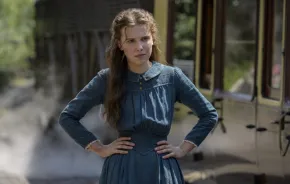
 People with disabilities are rarely represented in film. When they are, the stories tend to be heavy-handed and aimed strictly at an adult audience. And that’s a shame, because everyone benefits from diversity in film; movies are just as effective at creating empathy as books are and children with special needs should be able to see themselves represented on the screen.
People with disabilities are rarely represented in film. When they are, the stories tend to be heavy-handed and aimed strictly at an adult audience. And that’s a shame, because everyone benefits from diversity in film; movies are just as effective at creating empathy as books are and children with special needs should be able to see themselves represented on the screen.
As the second round-up in our new Family Movie Night series, here are some options for fine movies that portray disability in a positive light, from The MIracle Worker to Finding Nemo, and nurture empathy in kids. Did we miss one? Add it in the comments.
 1. On the Way to School (Sur le chemin de l’école)
1. On the Way to School (Sur le chemin de l’école)
This 77-minute French documentary for children has subtitles, but is mostly visual. On the Way to School follows four children on their way to school. Samuel is pushed 2.5 miles in a homemade wheelchair by his younger brothers. He has overcome great odds to attend school, but his is not the only difficult journey. Jackson avoids wild animals on the African savannah; Zahira crosses the Atlas Mountains weekly to reach boarding school and Carlito has a 90-minute horseback ride across the pampas. The filmmakers have used a gentle touch, with beautiful images and no voice-over narration. It is impossible to watch this film without thinking about how life’s challenges are both universal and relative.
Age recommendation: This film has not been reviewed on Common Sense Media, but I would recommend it for all ages despite the subtitles.
 2. Finding Nemo
2. Finding Nemo
Though this classic Disney/PIxar film is an obvious choice, many people forget that Finding Nemo’s endearing protagonist has a physical disability — a stunted fin that challenges his mobility — because it is handled so matter-of-factly.
The story draws much more attention to Marlin’s PTSD/anxiety disorder, Dory’s memory loss, the sharks’ addiction and the aquarium gramma’s OCD; it’s easy to be flippant, but it seems like every character in Finding Nemo is dealing with some issue — which is kind of the point. In Nemo’s world, being different is normal.
Age recommendation: Common Sense Media recommends this film for ages five and up.
 3. The Point
3. The Point
Remember this one? Dealing with difference more conceptually, The Point is about Oblio, a little round boy in a pointy world. This 1971 film is narrated by Ringo Starr with Schoolhouse Rock-style animation. Oblio and his loyal dog Arrow find value and meaning in a number of Wonderland-like nonsense adventures.
The slow pacing and Harry Nilsson soundtrack aren’t for everyone, but the film has a pointed message about valuing all people. Early scenes illustrate the logical absurdity of making people illegal and wraps up with a reminder that although it’s easy for individuals to convince themselves complicity in injustice is the only choice, action against injustice is as easy making a choice. The music, featuring such classics as "Me and My Arrow" is also very appealing.
Age recommendation: A lot of wordplay will go over kids’ heads, but there is nothing scary or inappropriate for very young viewers.
 4. The Miracle Worker
4. The Miracle Worker
The classic 1962 biography focuses on Anne Sullivan’s struggle to teach the blind and deaf Helen Keller how to communicate. Not only is the story a powerful depiction of the life of a severely disabled person, but it is also historically significant. Helen Keller was a lifelong activist who changed the way society understood disability, proving by example that people with disabilities could live full, rich and independent lives.
Age recommendation: Common Sense Media does not have a review for this film, but recommends it for ages 10 and up. Note: The film has several intense scenes that may be too much for very young children.
 5. The King’s Speech
5. The King’s Speech
Parents will love The King’s Speech for its powerhouse cast (Colin Firth, Geoffrey Rush, Helena Bonham Carter and Guy Pierce) and its historical treatment of interwar England. As for its appropriateness for family movie night, the R rating seems extreme to me and to most of the reviewers on Common Sense Media; there is no onscreen violence or sex, and almost all swearing takes place in one comical scene. Younger kids may have difficulty following the social and historical details, but the central story is simple. For a member of the royal family, whose duty is to serve as a national public figure, stammering is more than just inconvenient or embarrassing. As England slips closer to war with Germany and his older brother proves unfit for the throne, the Duke of York’s struggle to speak clearly becomes increasingly important.
Age recommendation: I would recommend this exquisite story of overcoming fear and meeting challenges for any child with patience for period drama.
 6. The Story of Luke
6. The Story of Luke
The Story of Luke is a humorous coming-of-age story in which the protagonist happens to be 25 years old and on the spectrum. Eschewing Hollywood happy endings, Luke makes a point of showing that Luke’s ordinary goals of getting a job and a girlfriend are not trivial for anybody; Luke’s worn-down uncle (Cary Elwes of Princess Bride fame) struggles to “be a man,” too. Seth Green, as his cynical coworker who is also on the spectrum, provides a counterpoint to the gentle Luke.
The movie’s greatest strength is in refusing to make Luke the object of sympathy. Instead, Luke is utterly relatable. Whether he is screaming in church or nervously asking a girl on a date, viewers always know exactly how he feels.
Age recommendation: The Story of Luke is not on Common Sense Media, but since Luke’s motivation is to get a girlfriend (“I want to screw,” he explains without quite understanding), this otherwise tame comedy skews to a teen audience.
 7. Where Hope Grows
7. Where Hope Grows
This PG-13 story about Calvin, a former professional ball player who befriends a grocery store employee with Down syndrome, deals with alcoholism and includes a scary accident in which a character dies. It’s a story of redemption through friendship that too often feels like an after-school special.
Unfortunately, it does fall prey to the “inspirationally disadvantaged” trope, in which a (usually white, male) protagonist learns important life lessons from a minority or disabled character. I’m including it in this list because despite its faults, it is the first movie in 25 years to give a major role to an actor with Down syndrome.
Age recommendation: For a teen audience.
 MORE FAB FAMILY MOVIE NIGHT SUGGESTIONS
MORE FAB FAMILY MOVIE NIGHT SUGGESTIONS
8 Film Adaptations that Might Be Better than the Book
10 Top Miyazaki Films for Kids
10 Top Non-Miyazaki Anime Films for Kids
5 Nature Documentaries Kids Love
5 Outdoor Adventure Films Kids Love
Girl Powerful: 15 Films with Super-Heroic Female Characters











